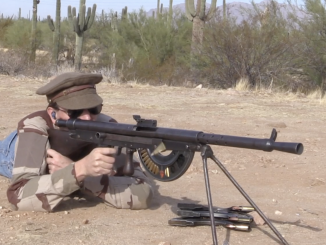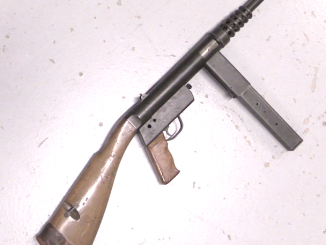In 1986, the French Army adopted the FR-F2 (Fusil à Répétition F2) as its standard sniper rifle. The F2 was never manufactured new; it was an improvement made on existing FR-F1 rifle by giving them new 7.62mm NATO barrels, new flexible bipods, and thermal sleeves over the barrels. Of 6,000 FR-F1 rifles original made, approximately 3,500 were rebuilt as FR-F2s. They served from 1986 until being officially replaced by the FN SCAR heavy in 2020.
The FR-F2 was an extremely accurate and capable platform, and saw use in Iraq, Afghanistan, Mali, and many other locations with French units.




Ian and his rifle, sittin in a tree, k I s s I n g. I’m jealous.
nice black friday purchase Ian. the scope is odd, but the scar heavy is also an odd choice for a sniper rifle. just an accurate infantry rifle, not a sniper. or am I missing something?
Ian? Did I miss something? “Best”? “Cold War”? That means a span of 40 years. No better ones then 40s tech manufactured in the 60s? I can not find anything in your video for deserve this term “Best”. Sorry.
Maybe your shooting test tomorrow show us some 1 inch groups at 300m and 3 inch groups at 600m.
But I doubt that. My German heart did not feel that a rear locking nut – thin barrel – 3-groove rifled can perform any outstanding groups. Maybe a good shooter but sniper…?
Eric, what would be your list of possibilities for the “best” cold war sniper rifles?
But how do you measure best-ness?
Hi, I do not know about the BEST. That is not my field of study. I collect pre 1899 Colt an Winchester.
I can only tell my experience with some I shoot by myself. I owned a Steyr SSG Police in the 1990s. With handloaded Norma cases, VV N140, Sierra Match and a Zeiss 4-12×56 I could hold the inner 10 (25mm) on the UIT target in my 100m indoor shooting range. Once I had the chance to use a Bundeswehr 300m outdoor range, there I was well within the 9 (100mm) with that ammo. A friend used a Tikka 55 Sporter and could almost match the groups, his groups mostly 1/2 or 1 caliber width bigger. To my knowledge both used in several country for military sniping.
By the way I see Ian shooting with that french rifle in the next video….
Yes my background is an ISSF/Olympic shooting club in Germany. That different to military shooting. But if you shoot groups like Ian do today then go inside the club room and start talking about sniper, sharpshooter, marksman…you will be the laughter of the month.
“(…)rear locking nut(…)”
This is itself does not prevent tight grouping, take for SSG 69
https://modernfirearms.net/en/sniper-rifles/standart-caliber-rifles/austria-standart-caliber-rifles/steyr-ssg-69-eng/
(…)With proper ammunition, the SSG 69 can deliver sub-MOA accuracy at ranges of up to 600 meters or so.(…)locking lugs are located at the rear of the bolt(…)
In rear locking guns, the receiver is stretched by the forces upon firing. (We often read about “bolt compression”, but is is receiver elongation!
Now compare the heavy tubular SSG receiver with minimal ejection port& magazine cutout, with the MAS…
If you will.
This is a pretty decent line rifle for a long-gone war.
Sturdy, reliable, low-cost and accurate enough.
Some, even from a Mosin rifle, managed to make something “sniper” or even “targeted”.
But the bedding receiver’s way into the stock leaves this rifle little chance.
Especially with match cartridges.
I wonder if Ian is good enough at targeting to figure out what this paddle is capable of?
It is a pity to miss such a chance.
I would be prepared to bet a reasonably large amount of money that this rifle is going to go off to 9-Hole Reviews, same as the FR-F1 did, and they are rather more able to get maximum long-range performance out of it than Ian. I’m certainly looking forward to it.
Best? Hmmm. The AI L96A1 entered service from 1982. The M40A1 in the seventies. The PSG-1 in 1972.
Also Walther WA 2000 https://modernfirearms.net/en/sniper-rifles/standart-caliber-rifles/germany-standart-caliber-rifles/walther-wa-2000-eng/
despite what number in designation might suggest was actually developed during late 1970s and early 1980s, I do not know when it entered service
The WA-2000 (and the other ‘ultimate german sniper rifle, the PSG-1, for that matter) was never a military service weapon, rather a design for special police units
And very few were made at that, mostly because even the German Bundesgrenzschutz (now the Federal Police)really wasn’t in the market for more than three or four high -precision rifles with a price tag each slightly higher than the average Audi.
There were less than two dozen WA2000s built, in .300 WM or 7.62 NATO. I have heard that one was built in 7mm Rem. Magnum, but that may or may not be correct.
There were also “practice” rifles built, externally almost indistinguishable from the centerfire version, in .22 WMR with a straight-blowback action. They were found to be quite effective on “live” targets out to 100 meters. (The .22 WMR is a round that is significantly more powerful than most people would expect from a “.22 rimfire”.)
Timothy Dalton used one of the .22 WMRs (firing blanks, of course)to “double” for the centerfire version in the 007 movie The Living Daylights (1987).
Overall, I can’t think of a rifle less likely to show up in a black op than one of these. You generally want something that’s hard to trace.
cheers
eon
According to the manufacturer, they built exactly 176, in 7.62 NATO, .300 Win Mag and a very few in 7.5 Swiss apparently as demonstration guns. (I can see how they might have thought that the combination of accuracy and overengineering would endear the WA-2000 to the Swiss).
I believe only one or two dozen ever came to North America, however
Very cool rifle!!! I was very excited when I found out these were coming in. But alas, the family would rather have the house payment paid, food in their mouths, and keep the electricity on than allow me to purchase one. But at least I got a close up view of yours!! Thanks Ian!!
You need Patreon supporters.
That’s currently a 7 thousand dollar rifle! https://navyarms.com/current-products/navy-arms-frf2-sniper-rifle/
And, at the time of the introduction of the FR-F1, France was not deciding “whether to join the NATO alliance”. It has been a member continuously since NATO was founded in 1952. In 1966 it left NATO’s “integrated military structure” – essentially meaning that French military units would no longer be in a command structure where they would be under the ultimate command of officers from other NATO countries in the event of war as part of multinational formations, in particular SACEUR (Supreme Allied Commander, Europe), a role always historically filled by an American.
They rejoined the IMS is 2009.
“(…)since NATO was founded in 1952(…)”
Uhm… but primal dozen joined NATO in 1949, not 1952.
https://www.nato.int/nato-welcome/index.html
namely
Belgium (1949)
Canada (1949)
Denmark (1949)
France (1949)
Iceland (1949)
Italy (1949)
Luxembourg (1949)
Netherlands (1949)
Norway (1949)
Portugal (1949)
The United Kingdom (1949)
The United States (1949)
In 1952 joined: Greece, Turkey
The bipod is a thing of beauty, and it’s only recently that some rifles have a similar balanced swivel system aligned with the bore.
https://www.forgottenweapons.com/history-of-the-fr-f1-and-fr-f2-sniper-rifles-henri-canaple-interview/
Jan is just wet.
In Britain we have L’s L this l that… No idea why.
Ian, I am disappointed that you use the term “POINT BLANK” to mean right in front of the
barrel.
—>>> Just as all the clueless media fools and authors do.
You know better.
POINT BLANK is the sight in distance (whatever it may be) where one will not need to hold
over to hit a circle of thus and such a diameter from +/- the distance of where the weapon
has been zeroed (what ever that is, too?), w/o holding off or adjusting the sights.
While you do some awesomely good stuff?
—> You do us all a disservice here by reinforcing the media claptrap.
I NEVER hear POINT BLANK used correctly. Actually? I HAVE NEVER HEARD IT USED CORRECTLY.
“She shot him POINT BLANK”, meaning at arms length? When the weapon was zeroed at 100
yards? That’s not POINT BLANK, DUDES!.
https://en.wikipedia.org/wiki/Point-blank_range